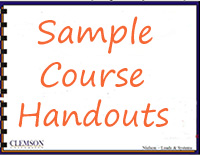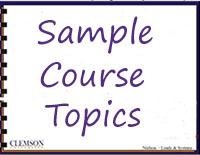2nd Summer Session (June 28-August 7, 2017)
Course: CE 2080 Dynamics
Course Description:
Forces and force systems and their external effect on bodies, principally the condition of equilibrium. The techniques of vector mathematics are employed, and the rigor of physical analysis is emphasized.
2.000 Credit hours
2.000 Lecture hours
Prerequisite: ENGR 1090/ENGR 1410 (Clemson students only), Calculus III and CE 2010 (Statics)
This 5-week course involves the same rigor, content and workload of a 15-week Dynamics course. Since this course will move three times faster than usual, students should anticipate spending a minimum of 24 hours/week on this course. In order to be in the best possible position to succeed, it is not recommended that students do more than one of the following while being enrolled in this course: have a part-time job, enroll in more than three other academic credits during the same five week term, go on a family vacation, or commit to other activities with significant time demands.
Course Material Presentations:
Video Sample; Class Handout Sample; List of Course Topics



Topics Covered:
Week 1
Includes Days 1-7 of the course content, with quizzes and assignments given each day.
Students will:
-
- Explain kinetics and kinematics.
- Distinguish between rectilinear and curvilinear motion.
- Relate position, velocity and acceleration.
- Derive and apply constant acceleration equations.
- Explain how position, velocity and acceleration are defined for curvilinear motion.
- Solve projectile motion problems.
- Explain normal and tangential unit vectors.
- Explain and apply normal and tangential acceleration.
- Solve dependent motion problems.
- Explain relative position, velocity and acceleration.
- Solve relative motion problems.
- Explain the types of rigid body kinematics.
- Determine the velocity of a point on a rotating rigid body.
- Determine the acceleration of a point on a rotating rigid body
Week 2
Includes Days 8-12 of the course content, with quizzes and an assignment given each day and Exam 1.
Students will:
-
- Define general plane motion.
- Determine absolute and angular velocity in plane motion using the vector method.
- Locate the instantaneous center of motion of a rotating rigid body.
- Determine absolute and angular velocity using the instantaneous center of motion.
- Explain Newton’s Second Law and apply it for the rectilinear motion of a particle.
- Apply Newton’s Second Law for the curvilinear motion of a particle using normal and tangential components of acceleration.
- Apply rigid body equations of motion for translation.
- Review key Statics concepts: two force members, internal and external forces, and free body diagrams.
- Identify and apply friction and normal force properties associated with sliding and tipping.
Week 3
Includes Days 13-18 of the course content, with quizzes and an assignment given each day.
Students will:
-
- Determine the mass moment of inertia for rigid bodies.
- Apply rigid body equations of motion for centroidal rotation.
- Determine the angular acceleration of rigid bodies with plane motion non-centroidal rotation.
- Explain vibration, free vibration and forced vibration and damping.
- Explain natural circular frequency, amplitude, phase angle, period and natural frequency.
- Analyze undamped free vibrations problems.
- Analyze undamped free vibration problems for particles and rigid bodies.
- Explain undamped forced vibration.
- Explain transient and steady-state vibration, magnification factor and resonance.
- Solve undamped forced vibration problems.
- Explain work, kinetic energy and power.
- Apply work and energy to relate force, mass, velocity and displacement of particles.
Week 4
Includes Days 19-22 of the course content, with quizzes and an assignment given each day and Exam 2.
-
- Explain potential energy of a conservative force, gravity and a spring.
- Apply conservation of energy to particles.
- Apply work and energy to rigid bodies in plane motion.
- Explain and apply linear impulse and momentum to particles.
Week 5
Includes Days 23-26 of the course content, with quizzes and an assignment given each day and Exam 3 and Final Exam.
Students will:
-
- Apply the conservation of linear momentum to a system of particles.
- Explain direct central impact, oblique central impact, eccentric impact and the coefficient of restitution.
- Solve direct and oblique central impact problems.
- Explain and apply angular impulse and momentum to particles.
- Explain and apply conservation of angular momentum to particles.
- Apply linear and angular impulse and momentum to rigid bodies in plane motion.
- Apply the conservation of momentum to rigid bodies in plane motion.
Assessment:
Homework Assignments submitted online—Engineering Paper, Scanner and Mastering Engineering Access Code required
Quizzes—Timely Submission in Blackboard required
Three Exams—Proctored On-site or Student Responsible for Obtaining Proctor —Process TBD (Sample Proctor Form)
Final Exam— Proctored On-site or Student Responsible for Obtaining Proctor at a Testing Center—Process TBD (Sample Proctor Form)
Regular Exams are scheduled from 3:30-5:30 pm EST on July 5, July 14, July 25. The Final Exam will be from 3:00-5:30 pm EST on July 29th. Onsite proctoring will be required and provided for all students residing within an hour’s drive of the Clemson University campus (during this term). Proctoring requirements for other students will be posted in the near future.
Instructor:
Name: Melissa Sternhagen
Email: MSTERN@clemson.edu
Phone: 864-656-6428
Student Outcomes—(ABET) This course contributes to the civil engineering student outcomes by developing:
-
- An ability to apply knowledge of mathematics through differential equations and science including calculus-based physics, chemistry, and at least one additional area of science appropriate to civil engineering.
- An ability to identify, formulate, and solve engineering problems.
Not a Clemson Student?
Undergraduate Students from other institutions who wish to enroll in courses during the summer only are considered transient students. Visit our "Registrar's" page for specific information regarding registration for summer classes.

